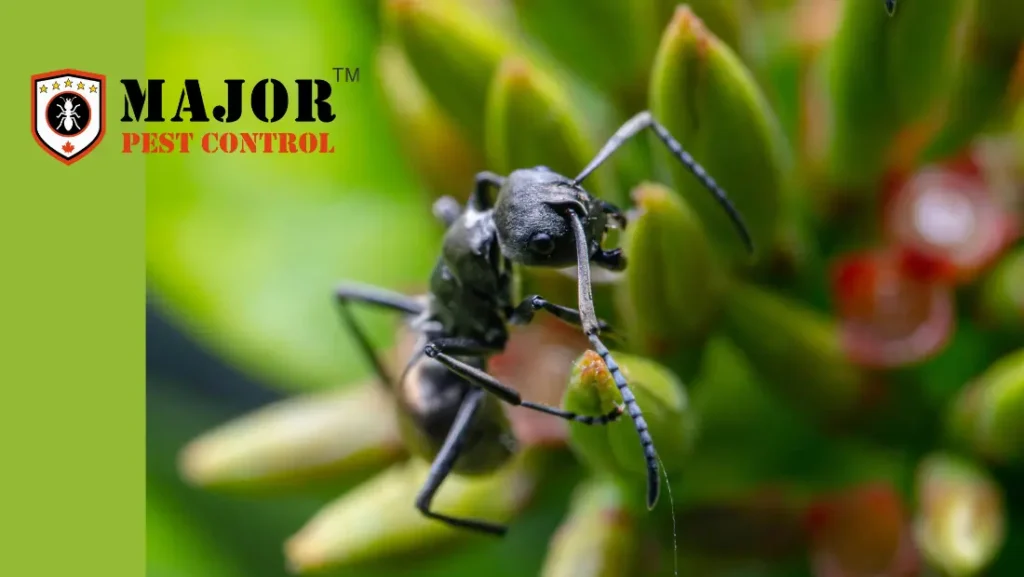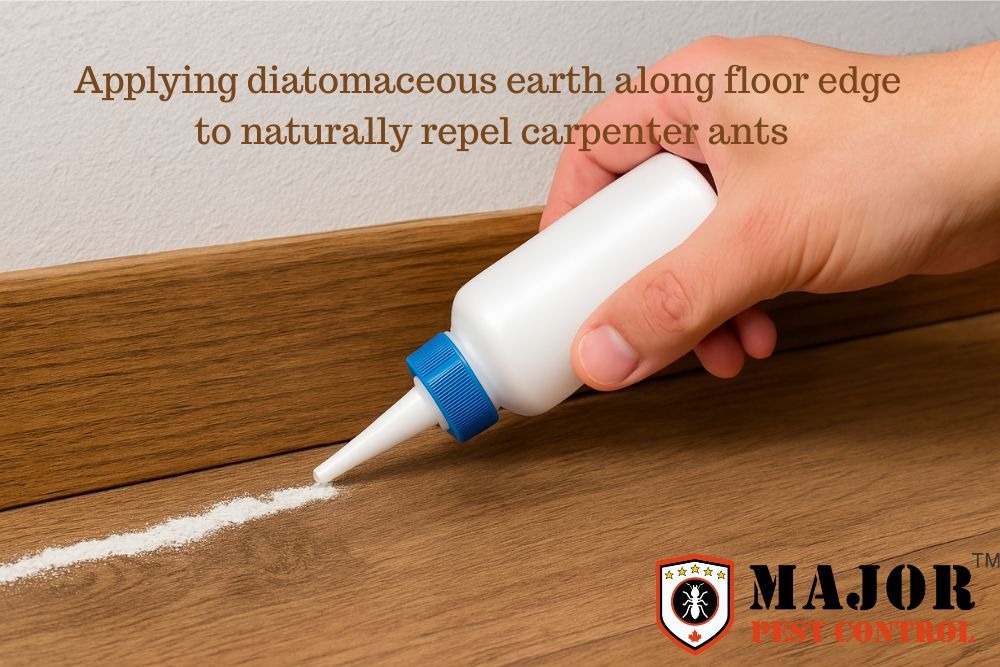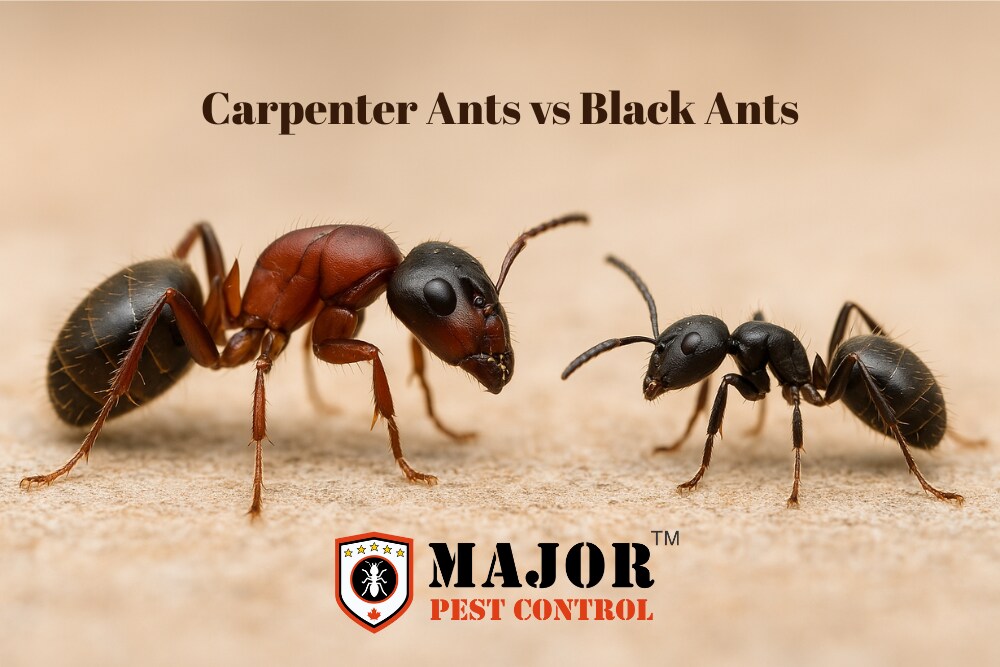At this time of the year, Edmonton homeowners are worried about how to control carpenter ants in Edmonton before they invade. Because these critters aren’t just creepy crawlers. They’re tiny homewreckers. Unlike regular ants, carpenter ants chew through wood like it’s their day job. They carve out tunnels that can quietly sabotage your walls, decks, or even support beams. The sneaky part? They work in silence, and most folks don’t realize there’s a problem until they spot sawdust piles or hear faint rustling in the walls.
But here’s the good news: you don’t have to wait for disaster. This guide is your go-to resource for spotting the early signs. This will help to shut down ant invasions before they start and tackle them head-on if they’ve already set up camp in your house. Let’s keep your Edmonton home solid, safe, and ant-free—no panic required.

What Are Carpenter Ants, Anyway?
Carpenter ants are some of the largest species found in Canada. They’re a top pest concern in Edmonton. Because they love moisture-damaged or decaying wood, that makes basements, attics, and older homes ideal nesting spots. You’ll find them where there’s been water damage or poor ventilation.
You can easily mistake them for termites, but carpenter ants don’t eat the wood. Instead, they dig tunnels and hollow out spaces to live in. Over time, this can seriously weaken your home’s wood beams and structural supports.
Signs of Carpenter Ants in Home
Carpenter ants don’t make a big scene. You might only spot subtle signs, like small clues that initially seem harmless. But if you know what to look for, you can catch an infestation early and stop the damage before it worsens.
- Wood shavings (like sawdust) near baseboards or windows.
- Rustling sounds inside your walls, especially at night.
- Big ants with wings show up in your home during spring.
How to Find a Carpenter Ant Nest
If you suspect carpenter ants are in your home, try to find their nest. This is the first step in eliminating them. To identify it-
1. Follow the Ants: Watch where the ants are coming from. They often follow the same paths, especially at night.
2. Look for Frass: Carpenter ants push out wood shavings (called frass) from their tunnels. You might see small piles near walls or baseboards.
3. Listen for Noises: In quiet rooms, you may hear faint rustling inside walls or wooden beams.
4. Tap the Wood: Knock on baseboards or door frames. Hollow-sounding wood can mean there’s a nest inside.
5. Check Damp Areas: They love moisture. Inspect spots near sinks, tubs, or where you’ve had leaks.
How to Get Rid of Carpenter Ants Naturally
Let’s be real: carpenter ants are the ultimate freeloaders. If you let them, they’ll happily chomp through your wood and throw a rager in your walls. But don’t panic! You can shut them down with a mix of smart habits and simple fixes before they move in. Here’s your game plan—no toxic sprays or drama required:

1. Fix Leaks Like Your Home Depends on It (Because It Does)
Carpenter ants are moisture junkies. A leaky faucet or soggy basement is basically their version of a five-star resort. Stay vigilant: patch drips, repair roof leaks, and dry out damp areas pronto. A dry home = an ant eviction notice.
2. Declutter the “Ant Airbnb” in Your Yard
Did firewood pile against your house? Rotting logs in the garden? That’s like rolling out a red carpet for ants. Stack firewood on raised racks (away from your house!) and clear out decaying wood. Your yard isn’t a free lumberyard—make that clear.
3. Seal Cracks Like a Pro (Caulk Is Your New BFF)
Ants are sneaky little ninjas. Grab some caulk and seal gaps around doors, windows, vents, and spots where pipes/wires enter your home. Think of it as closing the “back door” they’d use to sneak in.
4. Sprinkle Diatomaceous Earth—The Ninja Dust
Food-grade diatomaceous earth looks like harmless baking powder, but it’s kryptonite for ants. Dust it along baseboards, entryways, or ant trails. It dries them out naturally—no chemicals, no fuss. Pro tip: Use a tea strainer for a tidy application!
5. Plant a “No Ants Allowed” Garden
Grow mint, lavender, or lemongrass near your foundation. These plants smell like heaven to you but act like a giant “DO NOT ENTER” sign for ants. Bonus: Bees and butterflies will love you for it.
6. Stay Ahead of the Game (Because Pests Hate Consistency)
A little upkeep goes a long way. These steps don’t just deter carpenter ants—they’ll also help keep mice, spiders, and other creepy crawlies from crashing your space.
Stay Ahead with Regular Checks
Make monthly checks a habit. It doesn’t take long and could help you catch a problem early. Prevention is always easier—and cheaper than repair.
- Look for tiny piles of wood shavings.
- Tap wooden beams or baseboards—if they sound hollow, that’s a red flag.
- Set out ant bait as an early warning system.
- Early detection can mean the difference between a minor issue and major damage. If you act fast, treatment is easier and less costly.
Carpenter Ant Extermination DIY (How to Control Carpenter Ants)
DIY solutions can help with minor infestations, but they have limits. If the nest is hidden deep inside the walls, homemade remedies often won’t reach it. That’s when you need expert help.
Carpenter ant traps can help spot early signs of an infestation but won’t solve the problem completely. Most traps only catch the worker ants, not the queen or the hidden nest.
If you’re using bait-style traps, ensure they’re placed near known trails and in quiet areas where ants won’t be disturbed. While traps can reduce surface activity, they’re best used alongside professional treatment—especially if the ants keep returning.
In Edmonton homes, carpenter ants often nest deep inside walls or damp wood where traps just can’t reach.
Boric acid dust works well inside wall voids or cracks. But use caution—it can be harmful if not applied correctly.
Essential oils like peppermint may repel them but don’t count on it alone.
If you’ve tried multiple DIY methods and still see ants, it’s time to bring in professionals. They have the tools and expertise to locate and eliminate the entire colony—including the queen.
Carpenter Ants vs Black Ants
Here’s a clean and simple table comparing Carpenter Ants and Black Ants (Pavement Ants) in a way that’s easy for readers to understand and perfect for your blog post:

| Feature | Carpenter Ants | Black Ants (Pavement Ants) |
| Size | Larger – usually 6 to 13 mm (or more) | Smaller – around 2.5 to 3 mm |
| Colour | Black, reddish-black, or dark brown | Solid black or dark brown |
| Behaviour | Nest in wood by tunnelling through it | Nest in soil, driveways, or walls |
| Damage | It can weaken wooden structures if untreated | It is mostly a nuisance, with no structural damage |
| Threat Level | High – can lead to costly repairs | Low – more annoying than harmful |
What’s The Difference Between Carpenter Ants and Termites?
Carpenter ants and termites are often confused—but they’re very different pests and cause damage in various ways.
Carpenter Ants:
- Don’t eat wood—they dig into it to build their nests.
- Leave behind wood shavings or frass.
- Have bent antennae and narrow waists.
- Swarmers (winged ants) have uneven wing lengths.
Termites:
- Actually, they eat wood for food.
- Leave behind mud tubes and hollowed wood.
- They have straight antennae and thick waists.
- Swarmers have equal-length wings.
When It’s Time to Call a Pest Control Expert
The longer you wait, the more the ants spread. A pest control expert will know where to look, how to treat, and how to prevent them from coming back.
- You hear noises inside the walls.
- You’ve used bait, and the ants still keep showing up.
- You can’t find the nest.
At Major Pest Control Edmonton, we specialize in carpenter ants. We know how they operate, where they hide, and how to get rid of them for good.
FAQ
What is a carpenter ant queen, and why is she important?
The carpenter and queen are the heart of the colony. She’s much larger than the worker ants—sometimes up to 20 mm long—and her job is to lay eggs and grow the population.
In fact, one queen can live for up to 25 years and produce thousands of ants in her lifetime.
If you’re seeing a large wingless ant in your home, especially in spring or summer, there’s a chance it could be a queen looking to start a new colony. That’s a major red flag.
Removing worker ants won’t solve the problem if the queen is still alive and hidden inside your walls. That’s why professional treatment is often needed.
Do carpenter ants bite?
Yes, they can—but it’s rare. Carpenter ants have strong jaws and might bite if they feel threatened. The bite might pinch a bit, but usually isn’t dangerous. Some people may have mild skin irritation but are not venomous or aggressive like other pests.
Can carpenter ants come back after treatment?
Unfortunately, yes—if the nest wasn’t entirely removed or your home still has moisture problems. That’s why follow-up inspections and moisture control are so necessary. At Major Pest Control Edmonton, we don’t just treat the ants—we help you stop them from coming back.
How long does it take to get rid of carpenter ants?
It depends on the size of the infestation. Small colonies can be wiped out in a few days with the proper treatment. Larger infestations—especially ones inside walls—may take several weeks and more than one visit. Either way, the sooner you act, the faster we can solve it.
Are carpenter ants active year-round in Edmonton?
They’re most active in spring and summer, especially when it’s warm and damp. But if they’ve set up inside your walls or basement, they can stay active all year. If you see ants in the winter, that’s a big red flag. It means there’s a nest inside your home.
What are those big carpenter ants with wings?
If you’ve spotted big ants with wings in your home, especially in spring or early summer, you’re likely seeing carpenter ant swarmers—and that’s not a good sign.
These winged ants are reproductive males and queens. When conditions are right, they leave the nest to start new colonies. So if they’re inside your house, it often means a mature nest is nearby—maybe even in your walls, attic, or basement.
Swarmers don’t live long, but their appearance is a major red flag. This means that the colony is well-established and possibly growing.
Don’t wait. Winged ants indoors usually mean it’s time to bring in a professional to locate and eliminate the source before they spread further.
Final Thoughts
Take control before they take over. Regular checks and early action make a big difference. And when needed, call the experts.
Prevention, regular checks, and calling for help when you need it… that’s how you protect your home.
Need expert help in Edmonton? Contact us today. We’ll get rid of the ants and ensure they don’t return.
For additional insights and resources on voles prevention, check out this detailed guide from the National Pest Management Association (NPMA).

